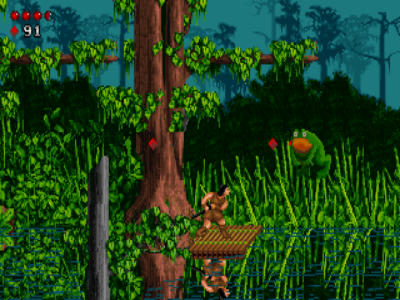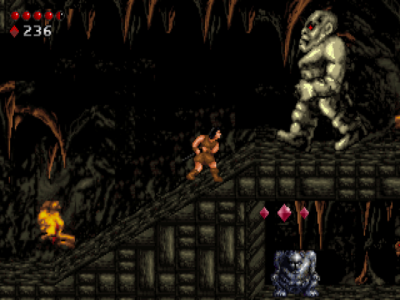
Realms of Chaos
Written by: Stoo
Date posted: October 17, 2021
- Genre: Action
- Developed by: Apogee Software
- Published by: Apogee Software
- Year released: 1995
- Our score: 7
Gog.com is still our favourite digital distribution site, and their sales remains a regular temptation. For ridiculously small amounts of money, you can add a multitude of games to your collection which you will never, ever find time to play. I tell myself, Stoo don’t buy any flight sims. You haven’t played one since 1996, you don’t have the patience, you’ll do the tutorial missions and then not touch it again for a decade. Also NO MORE RPGs. You still haven’t finished Might and Magic 6, you’re halfway through Dungeon Siege 2, and whatever the hell happened to Ultima Underworld. Also, after Rik powered through the entire damn Mass Effect trilogy shouldn’t you find time for at least one Bioware game?
That said I do at least allow myself the odd smaller diversion. That’s why, while looking to add to my stash of Apogee\3D Realms platformers, I picked Realms of Chaos more or less at a whim. I think it was their last platform game of the 90s, overshadowed by the growing prominence of their 3D output like Rise of the Triad and Terminal Velocity, with the mighty Duke Nukem 3D not far off. As such, I knew very little about this one.
Our setting is the fantasy world of Mysteria, where the situation is looking a bit grim. Monsters are attacking the human kingdoms, while the formerly friendly Myraal (cat people) and Goblins have become hostile. Some sort of evil force is at work, and two sibling heroes venture forth to defeat it: the warrior Endrick and the sorceress Elendra.
In keeping with Apogee tradition, the game is split into three chapters. The first was given away as shareware and, while not long enough to constitute a full game it was more than a mere demo and would keep you occupied for a few hours. Thus, so the idea went, engrossed gamers would demand more and shell out for the full package. Nowadays of course the whole bundle is less than a fiver anyway, although the shareware bit is still floating around out there.
You can flick between our heroes at any point with a tap of the spacebar, and each has clear strengths and weaknesses. Endrick can take more punishment, but is restricted to hacking at foes with his sword. Elendra can jump further and has superior offensive capabilties, able to fling fireballs across the screen both vertically and horizontally. However, these rely on a finite supply of mana crystals.
Realms wasn’t the first platformer to do something like this; we had for example Lost Vikings from Blizzard and Castlevania3 on the NES. Still, it’s a feature that’s executed quite well; actually it handles like a sort of proto-Trine. You need to consider who’s most useful in a given situation, but also preserve the health of wounded characters, as it’s game over if either dies. I found that later on in a chapter Elendra pulled ahead in overal utility, since plentiful mana crystals meant I could spam fireballs. Still I defaulted to Endrick with his extra hitpoint a lot of the time, keeping his sister in reserve for difficult enemies and bosses.
The blurb on the gog listing, lifted from 3D Realms’ own site, mentions RPG elements but don’t read too much into that. What you actually get are simple upgrades that are persistent for the rest of that chapter. Weapon strength is boosted from powerups scattered around levels that are hard to find, but worth the effort to help with for boss fights. Maximum health meanwhile can be increased by gathering treasure. This is quite liberally distributed but you need to gather a lot for each upgrade so again, you benefit from being thorough.
A lot of levels are fairly straightforward, although I’m going to go ahead and admit I was playing on easy mode. Some enemy behaviours took me off-guard, like the wolves that require you either quickly duck or jump over them. There were also points with cat guys jumping out of trees right on top of me that felt a little cheap. Also in some cases endlessly respawning, though I’m guessing that was a bug.
There is a bit of variety beyond the usual “fight to the end” routine; some levels are laid out as labyrinths and take a while to find an exit. Another uses a forced scrolling, that I’m guessing was inspired by Mario games, which lends a bit of urgency to procedures. Then there’s one dungeon-type map that’s made of spiked platforms moving up and down, with instant death if you blunder into them, and that one I’m convinced was lifted from Super Mario World.
There are one or two boss fights in each chapter, featuring some impressively large sprites. I flailed my way haplessly through these and mostly beat them by the smallest of margins, with just a tiny scrap of health left. In at least one case I found places to stand where the boss attacks never touch you, and of course I exploited the hell out of that. I imagine that on harder difficulties they’d be a decent challenge for gamers more competent than myself.
While Apogee’s earlier platformers had used the already-dated EGA graphics, 256-colour VGA is to be expected from a ’95 game. I still wouldn’t say the graphics are cutting edge but the artwork is quite appealing. At time it even evokes a Shadow of the Beast-ish sense of a misty distant fantasy realm (except without SotB’s fancy parallax scrolling). One level takes place in a swamp with reflective pools of water, and it has that kind of chilled ambience (apart from giant frogs trying to murder you) that prompted me to put the game on in the background while I get a bit of work done one evening.
On the audio side, the midi music was written by Bobby Prince, highly respected for his work on Doom. Here he’s not composing tributes to Slayer, but there’s a recognisable moody tone that carries over. Slightly incongruous with that and the relatively serious setting, yet very welcome at the same time, is the cheerful doodly-doo that plays when you pick up treasure. That sort of chiming effect is forever linked in my mind with 90s shareware games.
In an attempt to sum up, I’ve been sat here for a while (cup of Lapsang, you’re up too late again Stoo, toddler wakes up in a few hours) trying to decide what I took away from Realms. I think on some level, I found myself hoping for something a bit more ambitious and expansive. It hints at the potential for a game with perhaps more genuine RPG features, unique character abilities or emphasis on exploration. Still, it’s unfair to go to let the mind roam in idle speculation then hold the actual project up to the at ideal. This was obviously never going to be some sort twin-protagonist Metroidvania.
So let’s assess it in realistic terms: a platformer from the familiar Apogee production line of shareware games, and the work of a small handful of programmers. Something created for under-served MS-DOS users and we were happy to have it; consoles, Amigas and their slicker flashier games be damned (even if admittedly times were changing, new genres supplanting old and now we had Doom). Realms is solidly enjoyable, bar the odd frustration, and it does show progression and at least a few new ideas compared to the earlier apogee titles. As such, it’s worthy of its place alongside Commander Keen, Cosmo et al.
Now I suppose I should go finish an RPG…




 Posts
Posts